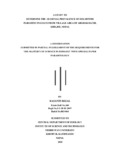Please use this identifier to cite or link to this item:
https://elibrary.tucl.edu.np/handle/123456789/3542| Title: | A Study to Determine the Seasonal Prevalence of Helminths Parasites in Goats From Village Area of Arghakhachi, Khiljee, Nepal |
| Authors: | Rizal, Basanti |
| Keywords: | Helminth;Trematodes;Cestodes |
| Issue Date: | 2010 |
| Publisher: | Central Department of Zoology |
| Institute Name: | Central Department of Zoology |
| Level: | Masters |
| Abstract: | Capra hircus (goat) being an important source of meat and livestock in Nepal has been considered in the present thesis world. This species is greatly affected by the helminthes parasites. The current study was carried out in order to observe the seasonal prevalence of intestinal helminthes parasites in goat. The samples were collected in the month of December/January, May/June and August/September. The total number of samples collected and examined for the study were 100, 100 and 50 respectively for these study period.The overall prevalence of helminthes parasite during December/January were 54%, in the month of May/June were 84% and in the month of August/September were 32%. During December and January (winter) 48.18% of infection were caused by Trematodes, 22.22% by Cestodes and 74.07% by Nematodes. In May/June (summer) 53.57%, 20.23% and 79.76% of infection were caused by Trematodes, Cestodes and Nematodes. Likewise 53.12%, 31.25% and 90% of infection were caused by Trematodes, Cestodes and Nematodes in the month August/September (rainy season).Nematode genus Strongyle has been reported in goats from other part of the world but not in goat of Nepal. So it has been reported for the first time in goat of Nepal.The prevalence percentage of identified genera of trematode are Dicrocoelium 7.05%., Fasciola 18.82% and Schistosoma 25.88%. Among cestodes, the genera identified with their prevalence percentage were found to be Moniezia 0.58% and Taenia 22.94%. Similarly the genera included in nematodes are Ancylostoma 3.52%, Ascaris 20%, Bunostomum 2.9%, Capillaria 8.2%, Chabertia 5.8%, Cooperia 6.47%, Dictyocalus 5.2%, Haemonchus 2.94%, Nector 2.94%, Oxyuris 0.58%, Strongyl 1.76%, Strongyloids 5.2%, Toxocara 2.35%, Trichuris 7%,Trichostrongylus 5.8%. Mixed infection was observed in 46.29%, 71.42% and 78.12% in the samples of winter, summer and rainy respectively. The difference in the prevalence of helminthes parasites during three seasons were found statistically significant ( 2 = 54.81, P < 0.05, d. f. = 1) Key words: Helminth, Trematodes, Cestodes, Nematodes, Parasite, Prevalence, Sedimention, Flotation. |
| URI: | http://elibrary.tucl.edu.np/handle/123456789/3542 |
| Appears in Collections: | Zoology |
Files in This Item:
| File | Description | Size | Format | |
|---|---|---|---|---|
| Chapter.pdf | 376.97 kB | Adobe PDF |  View/Open | |
| Cover.pdf | 54.95 kB | Adobe PDF |  View/Open |
Items in DSpace are protected by copyright, with all rights reserved, unless otherwise indicated.
